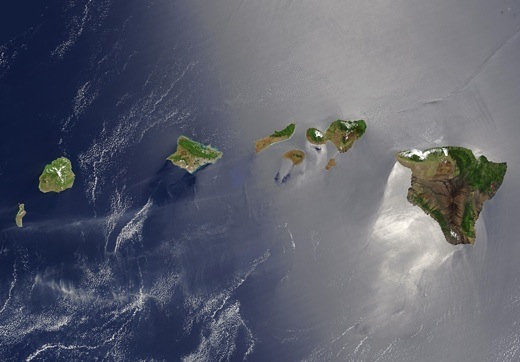By Henry Curtis on 30 November 2009 in the Honolulu Advertiser - http://www.honoluluadvertiser.com/article/20091110/OPINION03/911100309

Image above:NASA enhanced space view of Hawaiian islands. Note north is at upper left. From http://veimages.gsfc.nasa.gov/5429/Hawaii.A2003147.2110.250m.jpg
We import billions of dollars each year to buy foreign petroleum from unstable countries around the world. We can ask ourselves, how can we end that dependency? But that is the wrong question. The question that we need to ask is, what kind of society do we want? This is a proactive rather than a reactive question. We can go down several different paths.
One of them is to build an all-encompassing Big Brother system. We can build inter-island cables to tie our electric grids together. We can build a "smart grid," where the utility can measure the energy use of any given building every five minutes, or every minute, or continuously. The utility can give discounted rates to those who allow the utility to turn off devices within buildings during periods of peak demand.
All of these techniques are currently being discussed within Hawaii government departments and regulatory circles. These techniques would require that we spend billions of dollars of taxpayer and ratepayer money in order to expand the power and reach of the electric utilities. A very different path is building a distributed energy future. Each house, each building could minimize its energy footprint through the use of solar water heaters, efficient light bulbs, and other money saving systems.
Rooftop solar and wind could provide power for the building as well as for charging electric vehicles. Some buildings may not be able to provide all of their own energy. Therefore ratepayers could be paid to overbuild their renewable energy systems to pump excessive renewable energy into the electric grid.
All of these techniques are also currently being discussed within Hawaii government departments and regulatory circles. This debate is not new. When electricity was young, Edison and Westinghouse had the same debate. Edison favored local distributed generation. Westinghouse favored distant centralized power generation and long transmission lines. What is new is the urgency.
Climate change is the driver. The aging Hawaii electric infrastructure is the vehicle. We can focus on rebuilding and expanding the grid assuming that this approach may lead to increased renewable energy somewhere down the road. Or we can look to the personal computer and cell phone revolutions and build a decentralized electric infrastructure. The first step towards decentralization is feed-in tariffs.
This is a technical term for paying ratepayers to overbuild rooftop renewable energy systems to supply renewable energy to the grid. Unlike the more traditional net metering, feed-in tariffs would require the utility to pay the ratepayer for energy produced. This would enable anyone who is concerned about climate change to help everyone get off oil and other fossil fuels. T
his approach would also enable the state to get off the very dangerous path of substituting fossil fuels with biofuels made by chopping down the world's remaining rainforests. We must use the climate crisis and the aging electric infrastructure to build our vision of tomorrow, a decentralized renewable-energy world.
• Henry Curtis is executive director of Life of the Land. web: http://www.lifeofthelandhawaii.org
No comments :
Post a Comment